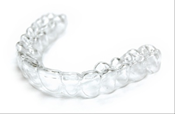Take Home Whitening
Take Home Whitening
Your appearance can affect you socially, emotionally and even in your business success. People who smile with confidence are viewed as warm, inviting and beautiful. Teeth whitening (or bleaching) is a simple, non-invasive dental treatment used to change the color of natural tooth enamel and is an ideal way to enhance the beauty of your smile.
Having whiter teeth has become the number one aesthetic concern of most patients and there are a number of ways to whiten them. Since teeth whitening only works on natural tooth enamel, it is important to evaluate replacement of any old fillings, crowns, etc. after bleaching so they match the newly bleached teeth.
Tooth whitening is not permanent. A touch-up may be needed every several years, and more often if you smoke, drink coffee, tea or wine.

Reasons for tooth whitening:
- Fluorosis (excessive fluoridation during tooth development).
- Normal wear of outer tooth layer.
- Stained teeth due to medications (tetracycine, etc.).
- Yellow, brown stained teeth.
What does tooth whitening involve?
This type of tooth whitening usually requires two visits. At the first appointment, impressions (molds) will be made of your teeth to fabricate clear, customized bleaching trays molded to fit your mouth perfectly.
At your second appointment, you will try on the trays for proper fit and adjusted if necessary. Depending on the degree of staining and desired level of whitening, the trays are worn one hour a day for two weeks with special whitening solution. It is normal to experience tooth sensitivity during the time you are whitening your teeth, but it will subside shortly after you have stopped bleaching. If your teeth are sensitive to bleaching, we may recommend a prescription toothpaste.
You will receive care instructions for your teeth and trays, and be encouraged to visit your dentist regularly to help maintain a beautiful, healthy, white smile.
What causes tooth discoloration?
Chemicals in foods, beverages and tobacco can change the color of your teeth, as can the effects of aging. Medications such as tetracycline, excessive fluoride and previous dental work may also cause unsightly stains on your tooth enamel. While we think of tooth enamel as white, the natural, unstained shade of your teeth can range from pearly white to bluish gray to pale yellow. Even if you brush and floss daily, stains can tarnish your beautiful smile and steal the confident image you want to convey.
Whitening Alternatives
If bleaching and whitening can’t get your teeth as white as you’d like, veneers or bonding may be a good solution. In addition to whitening your smile, veneers and bonding can cover cracks, chips and slight misalignment’s.

